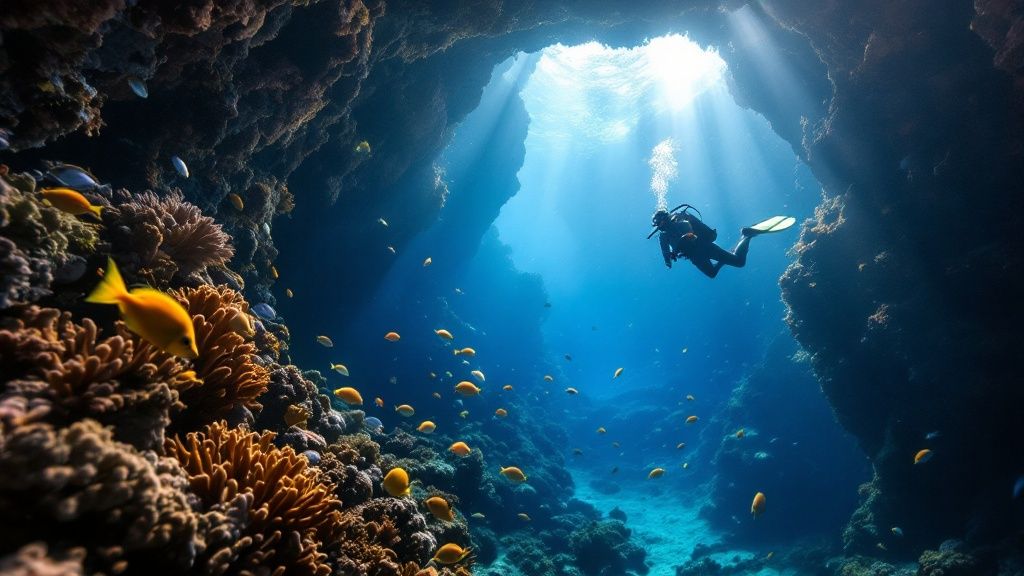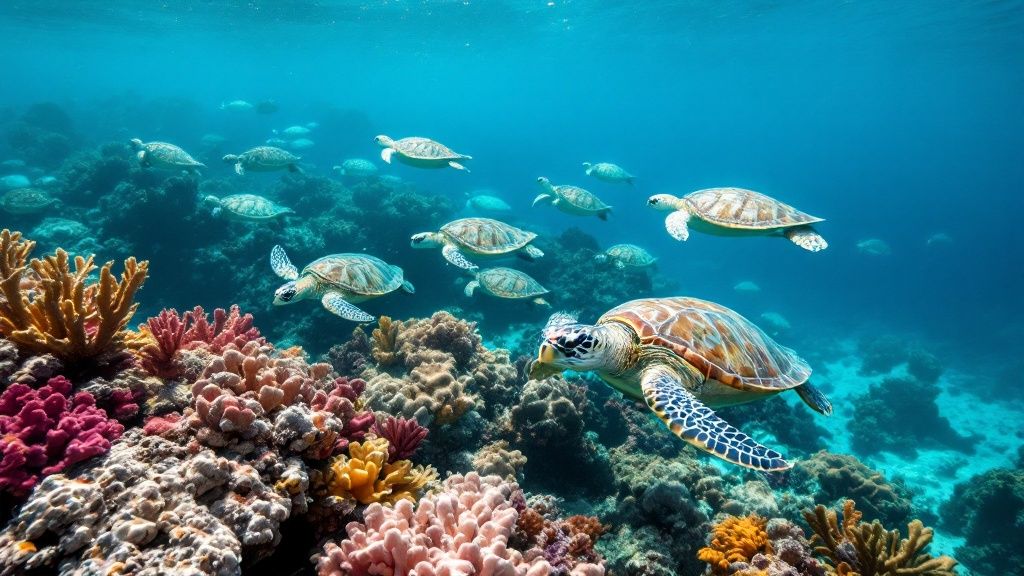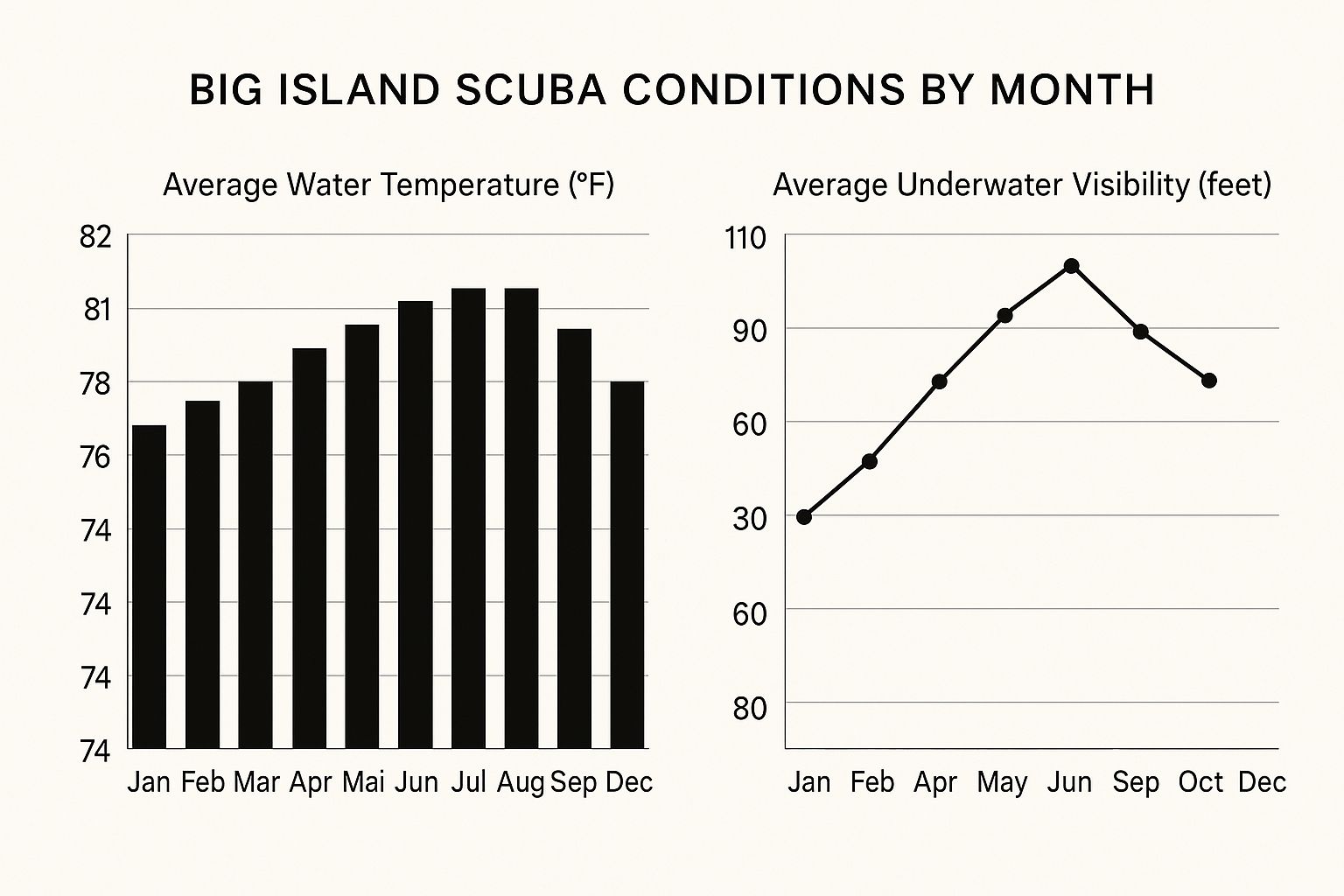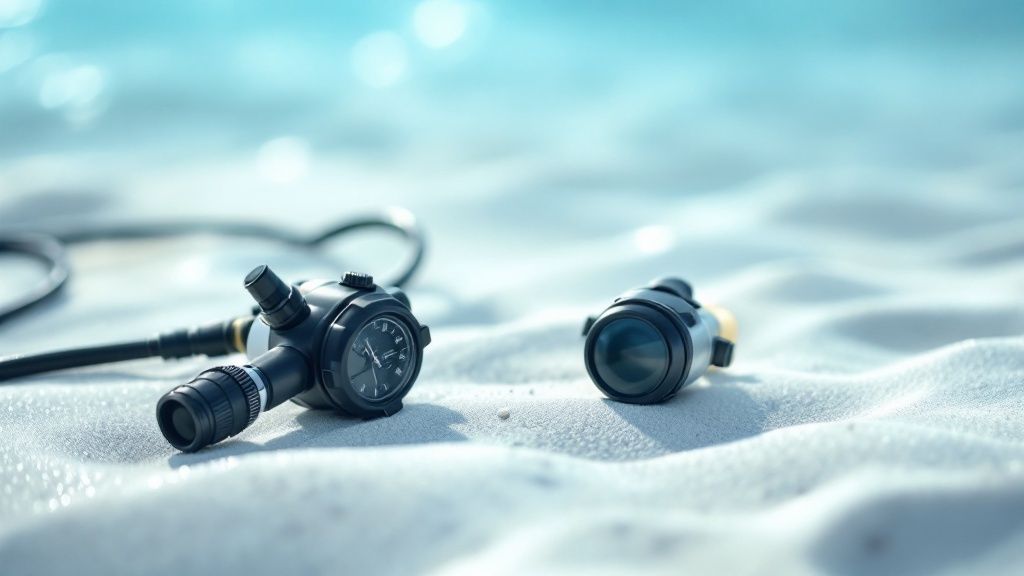Why Big Island Scuba Diving Outshines Every Other Destination
So, you're planning a scuba diving trip? You've likely seen brochures showcasing pristine waters and colorful reefs. But the Big Island of Hawai'i offers something truly special, a unique experience beyond typical crowded destinations. Talking with experienced dive masters and marine biologists reveals what makes Big Island scuba diving exceptional.
One key factor is the incredible variety of underwater terrain. Volcanic activity has created stunning formations, from lava tubes and caverns to towering pinnacles and arches. This unique seascape is constantly evolving as geological forces continue to reshape the underwater world, offering new dive sites to explore. This means even seasoned divers can always find something new and exciting beneath the waves.

The convergence of Pacific currents around the Big Island fosters a rich and diverse marine ecosystem. These currents bring nutrient-rich waters, supporting a thriving array of marine life. This translates to encounters with everything from manta rays and Hawaiian spinner dolphins to fish species unique to this area. For example, you might see a brightly colored reef triggerfish or a well-camouflaged scorpionfish.
Another advantage of Big Island scuba diving is its year-round accessibility. Unlike destinations limited by seasonal changes, Hawai'i’s consistently warm waters and excellent visibility allow diving adventures 365 days a year. Scuba Diving Hawaii: Everything You Should Know provides more detail about the best times to dive. While diving is possible throughout the year, specific seasons offer unique perks: winter (December to February) for whale watching, spring (March to May) for calmer seas, and summer (June to August) for peak travel season with warm, calm conditions. September and October are often considered the best months due to excellent visibility, favorable water temperatures, and fewer crowds.
Why Choose the Big Island?
- Unique Volcanic Landscapes: Explore fascinating underwater lava formations.
- Incredible Marine Biodiversity: Discover a vibrant ecosystem teeming with life.
- Year-Round Diving: Enjoy consistent conditions without seasonal restrictions.
- Unforgettable Experiences: Create lasting memories, from manta ray night dives to exploring hidden reefs.
The Big Island isn’t just another dive spot; it's an underwater paradise waiting to be explored. Leave the crowded tourist areas behind and experience truly extraordinary diving in the heart of the Pacific.
Manta Ray Night Dives: The Experience That Changes Everything
Nothing compares to the breathtaking wonder of a Big Island manta ray night dive. Imagine yourself suspended in the dark ocean, weightless, as 20-foot manta rays gracefully glide mere inches from your face. This isn't just a captivating story; it's the reality of the Big Island's most iconic scuba diving experience.
This extraordinary encounter is consistently spectacular thanks to a perfect combination of factors, beginning with the oceanographic conditions. Specific locations around Kona, like Manta Village and Manta Heaven, are rich in plankton, the main food source for manta rays. Bright lights, whether from coastal resorts or specialized dive lights, attract this plankton, drawing the mantas in for their nightly feast. This creates a predictable and reliable environment for these unforgettable interactions. You might be interested in: Manta Ray Night Dive Kona.
The Magic of Manta Encounters
Furthermore, ethical guidelines ensure the safety and well-being of both divers and these gentle giants. Divers are instructed to remain still on the ocean floor, creating a peaceful and undisturbed setting for the manta rays to feed. This respectful approach allows for close observation without disrupting their natural behavior. The Big Island of Hawaii offers a truly exceptional scuba diving experience, especially with its manta ray night dives. These dives are incredibly popular, with consistent reports of around 15 manta ray sightings per dive. The price typically ranges from $150 to $200 per person, reflecting the thriving tourism centered around scuba diving. Ethical standards are in place to ensure respectful observation and minimize any disturbance to the manta rays and their environment. Explore this topic further.

Why These Dives Are So Successful
These night dives boast remarkably high success rates thanks to the consistent presence of manta rays at these feeding locations. This means divers have a great chance of witnessing this awe-inspiring spectacle. Even if a manta ray sighting doesn't occur, the experience of a night dive itself is often unforgettable. The underwater world transforms at night, showcasing unique creatures and behaviors seldom seen during daylight hours.
Tips for an Unforgettable Manta Dive
-
Choose a reputable dive operator: Look for operators dedicated to sustainable practices and manta ray conservation.
-
Follow instructions carefully: Adhering to the guidelines safeguards the well-being of the manta rays.
-
Position yourself strategically: Divers are typically positioned on the seabed, allowing the mantas to swim freely above.
-
Bring an underwater camera: Document the magic of these encounters, but use your light responsibly.
This one experience alone is worth the entire trip for many Big Island scuba diving enthusiasts. It's an opportunity to witness the beauty and elegance of these amazing creatures up close, creating memories to cherish for a lifetime. Read also: Manta Ray FAQs and How to dive with mantas.
Essential Dive Sites That Define The Big Island Experience
Beyond the famous manta ray night dives, the Big Island offers diverse scuba diving experiences. From ancient lava flows forming cathedral-like caverns to vibrant coral gardens teeming with endemic Hawaiian species, every site has a unique geological and biological story. This guide explores must-dive locations for all skill levels, from beginner-friendly turtle cleaning stations to challenging deep-water pinnacles for advanced divers.
Exploring Kona's Underwater Treasures
Kona is one of the most popular areas for Big Island scuba diving. It offers abundant dive sites with diverse experiences. Beginners can join Kona Honu Divers on trips to shallow reefs, observing colorful fish and gentle sea turtles. More experienced divers can explore deeper caverns and lava tubes, evidence of the island’s volcanic origins. Swimming with manta rays is a magical Big Island experience; learn more in this guide to a Manta Ray Snorkel Big Island Ultimate Adventure.
Sites For Every Diver
-
Manta Heaven (or Garden Eel Cove): True to its name, this site is known for manta ray sightings, especially during night dives. Its relatively shallow depth makes it accessible to various skill levels. Learn more in this article about Big Island Diving.
-
Manta Village: Located off Keauhou's coast, this site boasts a high success rate for manta ray encounters. Several operators offer specialized night dives.
-
Kealakekua Bay: Known for its calm waters and abundant marine life, this sheltered bay is excellent for beginners and snorkelers.
-
Place of Refuge: This area offers fascinating underwater lava formations, a great choice for exploring unusual underwater landscapes.

The infographic above shows the average monthly water temperature and underwater visibility for Big Island scuba diving. Water temperatures stay consistent year-round, ranging from the low 70s (°F) to the low 80s (°F). Underwater visibility is generally good, typically over 60 feet, peaking in the fall. Divers can enjoy comfortable conditions throughout the year, with slightly better visibility during certain periods.
The following table provides a more detailed comparison of these top dive sites:
Top Big Island Dive Sites Comparison: Comprehensive comparison of the most popular dive sites including depth, difficulty level, marine life highlights, and best conditions for diving
| Dive Site | Max Depth | Difficulty | Marine Life Highlights | Best Season |
|---|---|---|---|---|
| Manta Heaven | 40 ft | Beginner | Manta rays, garden eels | Year-round (night dives) |
| Manta Village | 30 ft | Beginner | Manta rays, reef fish | Year-round (night dives) |
| Kealakekua Bay | 30 ft | Beginner | Reef fish, coral, historical site | Year-round |
| Place of Refuge | 60 ft | Intermediate | Lava formations, reef fish | Year-round |
This table highlights the varying depths and difficulty levels of these popular sites, allowing divers to choose a location that suits their experience. It also showcases the unique marine life highlights of each site, from the majestic manta rays to the vibrant coral reefs.
Beyond Kona: Expanding Your Diving Horizons
While Kona is a scuba diving hub, other areas of the Big Island offer equally rewarding experiences. The Kohala Coast is known for its pristine reefs and diverse marine life. Some areas offer unique opportunities, such as blackwater diving, encountering deep-sea creatures in their natural habitat. This demonstrates the incredible range of Big Island scuba diving options.
By exploring these diverse locations, divers can experience the full spectrum of Big Island scuba diving. Each site offers a unique glimpse into the underwater world, ensuring a memorable adventure suited to individual skill levels and interests.
Decoding The Big Island's Incredible Marine Ecosystem

The Big Island's location in the Pacific Ocean is key to its marine diversity. Sitting at the crossroads of major ocean currents, it acts as a biological intersection. This intersection welcomes both native Hawaiian species and migratory visitors from across the vast Pacific. This unique mix creates an underwater paradise, especially for those interested in Big Island scuba diving.
Endemic Wonders and Pacific Visitors
The Big Island's waters are home to a captivating mix of resident and migratory species. Hawaiian green sea turtles, known for their gentle nature, are a common sight. They gracefully navigate the reefs alongside endemic fish, found nowhere else on Earth. These fish paint the coral gardens with vibrant color. Occasionally, lucky divers might spot the endangered Hawaiian monk seal, one of the rarest seal species. For shore diving enthusiasts, this article provides further information: Where to go shore diving on Big Island.
The marine ecosystem extends beyond the shoreline. The Big Island is a critical stop on migration routes for several magnificent creatures. Humpback whales, known for their breaches and songs, visit during the winter months to breed and calve. Manta rays, with their impressive wingspans, gather to feed on plankton, offering the unforgettable experience of manta ray night dives. Pelagic fish, such as tuna and marlin, also pass through these waters, adding another dimension to Big Island scuba diving.
The Volcano's Impact on Marine Life
Volcanic activity plays a continuous role in shaping the Big Island's marine environment. The constant lava flow creates new underwater formations, altering the seascape. This means even familiar dive sites can change over time, offering fresh explorations for experienced divers.
Newly formed lava tubes and caverns can become habitats for unique species adapted to these specific environments. These geological forces influence nutrient distribution and water temperatures, impacting marine life. Understanding the various sound frequencies, including those amplified by subwoofers, can enhance appreciation for this ecosystem. These dynamic processes highlight the connection between the island’s land and sea. This constant change makes each Big Island scuba diving adventure a unique and potentially revealing experience.
Planning Your Big Island Diving Adventure Like A Pro
Turning your Big Island scuba diving dreams into a reality takes more than just grabbing a plane ticket. It involves careful planning and a bit of insider knowledge to truly make the most of your underwater experience. This includes choosing the right dive operators, understanding the gear you'll need in Hawaiian waters, and picking the perfect time for optimal conditions.
Choosing the Right Dive Operator
Finding a reputable dive operator is essential for a safe and enjoyable experience. For example, Kona Honu Divers prioritizes both safety and marine conservation, boasting over 200 years of combined industry experience. Look for operators who emphasize sustainable diving practices, small group sizes, and seasoned guides.
Also, consider operators offering specialty dives, like the famous manta ray night dive or blackwater dives. These unique dives create unforgettable memories catered to specific interests.
Gearing Up for Hawaiian Waters
Understanding the gear requirements for Big Island scuba diving is key. While some operators offer rentals, bringing your own ensures a comfortable fit and that familiar feel. Check out this helpful guide on the gear you will need for your Kona diving adventure.
Think about water temperatures, which typically range from the low 70s (°F) to the low 80s (°F), and pack accordingly. A 3mm wetsuit is generally sufficient, but a 5mm wetsuit might offer added warmth, especially during night dives.
Budgeting for Your Dive Trip
The cost of scuba diving on the Big Island varies depending on a number of factors. Single tank dives can start around $150, while multi-dive packages or specialty dives like the manta ray night dive can be more expensive, sometimes exceeding $200.
Remember to factor in equipment rental costs if you aren't bringing your own. A realistic budget will let you enjoy a range of dive experiences without any unexpected financial strain.
To help you plan your budget, take a look at the table below detailing various diving costs:
Big Island Diving Cost Breakdown: This table offers a detailed cost analysis for different types of diving experiences, equipment rental, and certification courses to help budget your diving adventure.
| Service Type | Price Range | Duration | What's Included | Best For |
|---|---|---|---|---|
| Single Tank Dive | $150-$180 | Half-day | Tank, weights, guide | Beginners, budget travelers |
| Two-Tank Dive | $200-$250 | Full-day | Tanks, weights, guide, lunch | Experienced divers, exploring multiple sites |
| Manta Ray Night Dive | $180-$220 | Evening | Tanks, weights, guide, specialized lighting | All levels, unique experience |
| Equipment Rental | $25-$50 per day | Varies | Wetsuit, BCD, regulator, mask, fins | Divers without own equipment |
As you can see, the cost varies depending on the type of dive and whether you need to rent equipment. Planning ahead and considering these costs will ensure a smoother trip.
Timing Your Dive for Optimal Conditions
Timing is crucial when planning your Big Island diving adventure. While diving is possible year-round, the ideal time depends on what you want to see. Winter months (December-February) are perfect for whale watching, while spring (March-May) offers calmer seas and improved visibility.
Summer (June-August) is the busiest tourist season, but also features warm water and calm conditions. September and October are favorites for many, offering excellent visibility, comfortable temperatures, and fewer crowds.
Booking Your Dive and Beyond
Popular dives, especially the manta ray night dive, often require booking well in advance. These dives can fill up quickly, so reserve your spot early, particularly during peak season.
Don't forget to combine your scuba diving with other island adventures! Exploring volcanic landscapes, visiting coffee plantations, or just relaxing on the beach are all fantastic complements to your underwater explorations.
The Rich Heritage Behind Big Island's Underwater Exploration
The waters surrounding Hawaiʻi Island, better known as the Big Island, offer much more than stunning recreational scuba diving. They provide a unique glimpse into a rich history of ocean exploration and marine discovery, connecting modern divers with the underwater pioneers of the past. From ancient Polynesian navigators to today's marine researchers, the Big Island's waters continue to inspire.
Ancient Navigation and Modern Science
Centuries ago, the first explorers of these waters were Polynesian voyagers. They navigated by the stars, currents, and an intimate understanding of the ocean's nuances. This profound connection with the sea continues to inform modern marine conservation efforts. Want to experience the magic of these waters at night? Find out more about manta ray night dives. Today, scientific research thrives in these same waters, uncovering the intricate workings of the underwater world. Ongoing projects focus on coral resilience, manta ray behavior, and the distinctive characteristics of volcanic marine ecosystems.
Uncovering the Deep's Secrets
Historical milestones in deep diving and exploration near the Big Island showcase the evolving relationship between humans and the ocean. In 1984, the submersible Makalii completed fourteen dives in the Northwestern Hawaiian Islands, reaching depths of 366 meters. This groundbreaking work marked the first exploration of these deeper ecosystems. Delve deeper into the history of deep-sea exploration in the Hawaiian Islands. This pioneering spirit continues to fuel exploration in the Pacific, with the Big Island serving as an essential hub for deep-sea research.
Archaeological Discoveries and Cultural Significance
The ocean floor surrounding the Big Island holds more than just natural wonders. Archaeological discoveries in these waters offer a fascinating window into the past, revealing ancient settlements and offering valuable insights into the history of human interaction with the marine environment. This underscores the importance of responsible diving and preserving these underwater treasures.
A Living Laboratory of Marine Life
The Big Island's volcanic activity has significantly shaped the marine ecosystem. New lava flows continually reshape the underwater landscape, creating unique habitats and influencing the distribution of nutrients and water temperatures. This dynamic environment makes it an ideal location for scientific discovery, attracting marine biologists eager to study the complex relationships within this ever-changing ecosystem.
The Future of Big Island Diving
Big Island scuba diving offers more than just recreation; it's a connection to a legacy of exploration, scientific discovery, and cultural heritage. By understanding the historical and scientific significance of these waters, divers develop a deeper appreciation for the unique opportunity to explore this underwater world and contribute to its preservation for generations to come.
Maximizing Your Big Island Diving Experience
Your Big Island scuba diving adventure should be extraordinary. This section will help you prepare for an unforgettable experience, covering preparation strategies specific to Hawaiian waters, essential safety tips, and responsible ways to document your underwater encounters.
Preparing for Hawaiian Waters
While the Big Island offers diving opportunities year-round, a little preparation can significantly enhance your experience. Consider these tips before you dip in:
-
Gear Up: Water temperatures typically range from the low 70s (°F) to the low 80s (°F). A 3mm wetsuit is usually sufficient, but some divers prefer a 5mm for extra warmth, particularly during night dives. Maintaining your gear in the tropical climate is crucial. Rinse all equipment with fresh water after each dive and allow it to dry completely to prevent corrosion.
-
Choose Reputable Operators: Opt for reputable operators like Kona Honu Divers that prioritize safety and marine conservation. Look for certifications, experience, and a commitment to sustainable practices. This protects both you and the delicate marine environment.
-
Plan Ahead: Popular dives, such as the manta ray night dives, often sell out, especially during peak season. Book these experiences well in advance to avoid disappointment. Securing your dive plans early allows you to relax and focus on enjoying your trip.
Safety Beyond the Basics
While basic dive training is required, the Big Island’s unique environment necessitates extra precautions.
-
Current Awareness: Some areas experience strong currents. Always heed your dive guide’s instructions and stay within the designated dive areas. Familiarize yourself with local dive conditions and be prepared for potential changes in visibility or water movement.
-
Marine Life Respect: Admire the incredible marine life from a distance, avoiding touching coral or disturbing animals. This respectful approach protects both you and the ecosystem. Touching a manta ray, for instance, can remove its protective mucus layer, making it susceptible to infection.
-
Dive Buddy System: Always dive with a buddy and maintain clear communication throughout the dive. This fundamental safety practice is even more crucial in varied conditions. Regularly check each other's air supply and stay close enough to provide assistance if needed.
Documenting Your Dives Responsibly
Capturing your underwater memories is a must, but it's vital to do so responsibly.
-
Light Usage: Use underwater lights judiciously, especially at night. Minimize disturbance to marine life by avoiding shining lights directly into their eyes. Some creatures are highly sensitive to light, and responsible use helps minimize their stress.
-
Buoyancy Control: Maintaining proper buoyancy control is essential to prevent accidental contact with coral reefs. This protects both the reef and your diving equipment. Even a slight touch can damage delicate coral formations.
-
Respect Wildlife: Resist the urge to chase or harass marine life for the perfect photo. Patience and observation will yield the best results and minimize stress on the animals.
Extending Your Big Island Experience
Make the most of your trip by combining diving with other exciting activities.
-
Volcano Tours: Explore the volcanic landscapes that shaped the very dive sites you explore, offering a deeper understanding of the island's geology.
-
Cultural Experiences: Immerse yourself in the local culture by learning about traditional Hawaiian ocean knowledge and its connection to the marine environment.
-
Specialty Courses: Expand your dive skills with locally offered specialty courses such as night diving or underwater photography.
Connect with the Big Island diving community and consider planning return trips to further explore the incredible diversity this area has to offer. Book your next underwater adventure with Kona Honu Divers for an unforgettable Hawaiian experience.
